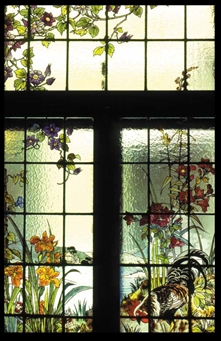Building of the National Library
The former mansion of the Ushkovs, once widely known industrialists, is one of the most beautiful buildings of our city. Since 1919, the building is occupied by the National Library of the Republic of Tatarstan. The visitors to the Library can daily admire the beauty of magnificent decoration preserved from the time it was built. Would it be possible to preserve the beauty of the building, if there were something else, but the library, in it? We know that after the revolution it housed the city printing house.
We have the initial plan of the interior. Former trading halls on the ground floor were built as an enfilade and were separated from back rooms. The first floor had the same lay-out for front rooms. The building was richly decorated with stucco moulding. The architectural composition, decorative appointments of elevations and interiors display thorough mastery, and splendid decoration stagger imagination. Of great interest is the interior of the front staircase built in the "Shinouasri" style and designed as an entrance to rooms of an Oriental ruler: gilded carved dragons on walls, doors, ceiling and wooden railing of the staircase, bronze decoration and stucco moulding, pictures of Japanese deities, imitation of ancient Chinese painting, the picture painted to look like an expensive silk cloth. The light picturesque panels with sketches of everyday Oriental life are framed by imitation of bamboo. Door handles are all different and can be considered as real works of art.
Stained-glass windows with exotic landscapes, rare birds and plants are superb. The floor is enchased with marble and gilding (branches of flourishing cherry-trees, the favourite Japanese motif).
According to tastes of the end of 19th - beginning of 20th centuries, the building was decorated in different styles. The main room is decorated in Empire style: ceilings are covered with rich ornamental design including military themes (shields, swords, flags, eagles, winged lions and horses). The interest of the owners in Napoleon is manifested in the Latin monogram N on the ceiling. High lacquered doors are decorated with high-relieves of eagles and the picture of Gorgon.
The walls of the former dining-room decorated in the Gothic style of German castles of the Middle Ages are planked with panels of fumed oak. The ceiling is divided into caissons. On the top, there is a small gallery for orchestra. The former green reception-room in Rococo style has fireplaces of Empire form made of green Italian marble with bronze decorations and mirrors. Another version of the same fireplace is in the cabinet of the owner. The fireplace is decorated with bronze girandoles and a cast figure of bison. A small pink sitting-room is an elegant room with light painted doors and ceiling with vignettes, loves, medallions with flowers. The peculiar feature of the Moresque hall (former smoking-room) are the doors decorated with Arabic character that encoded the main postulate of Islam: "No other God, but the Allah-". But the true pearl of the mansion is an original winter garden-grotto, where everything resembles a natural cave: green plants push through natural coquina in cracks between rough large blocks of the wall covering. Stalactites hang down from the ceiling; the huge aquarium is decorated with shells, stones and a small fountain in the form of some strange fish. Windows constitute the major part of the exterior wall, and the room, when lit in evenings, is especially beautiful from the street: it is like a window to a Fairyland.
The floors in the front rooms are covered with glued-laminated parquet; the floors on the ground floor are covered with ceramic tiles (manufactured, as the reverse side of tiles says it, at the plant of the owner).
The architect, K.L. Muefke (1868-1933), who built this miracle in 1908, was born on January 30th, 1868, in Voronezh. After graduating from grammar school he enrolled in the Petersburg Academy of Arts, where he was many times awarded small and big medals for his designs. After the Academy he became an architect and an artist, and visited many foreign countries. During his business trip to Europe, he saw specimens of culture of Italy, France, Austria, etc. Having come back to Russia, he got the job at Kazan Art School (1897-1912). In 1898, he was unanimously elected Director of the School by the staff council. Due to his efforts and capable management, the School acquired a building, which was probably best suited, both from artistic and practical sides, for educational institution of the time. Muefke was notable for exceptional capacity for work: he combined his work as a teacher and state service with creative activity. Pluralistically he was an architect of Kazan University (1905 - 1909). The positive responds from the side of the Academy and academicians, and success of his students testify to how fruitful was the activity of Muefke.
In 2020, the National Library of the Republic of Tatarstan moved to a new modern building.
Video Tour of the Building
A Photographic Tour of the Building
Fragments of the Interior of the Second Building of the Library
Last updated: 19 March 2025, 17:01
.jpg)


.jpg)
.jpg)